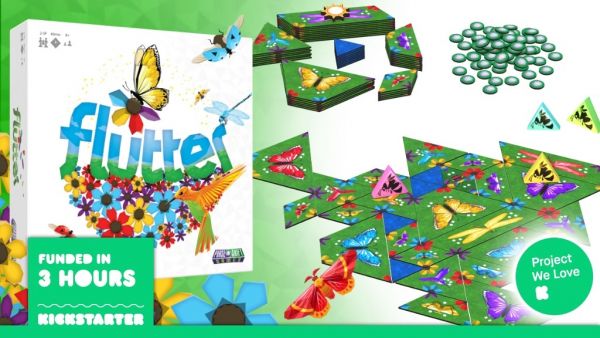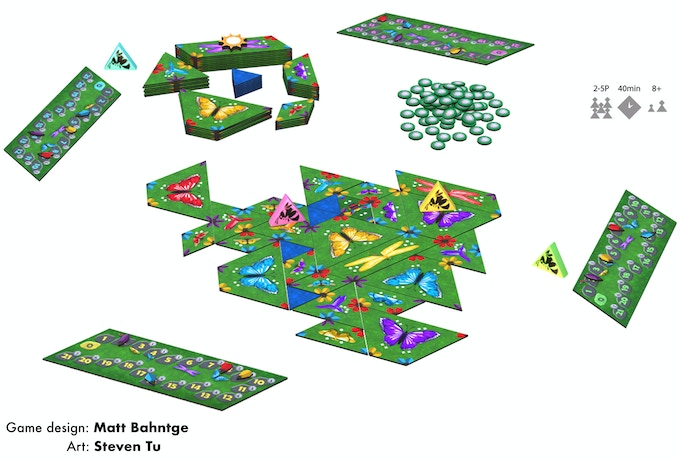Preview: Build a Vibrant Ecosystem in Flutter

In this 2-5 player tile-laying game, players will be trying to grow flowers and help pollinators while they also chase their own pollen points toward victory.
Gameplay
Flutter begins with each player claiming one bee token and petal tracker of their chosen color. The meadow tiles are shuffled (according to their unique shapes) and placed in a circle of five piles. The number of meadow tiles is determined by the player count. The sun token is placed on the smallest meadow tile pile. Petal and pollen tokens are placed within reach of all players, and the starting Rainbee title is placed in the middle of the table.
Each turn involves six actions, all centered on drawing and placing meadow tiles in an expanding ecosystem. The first action will have players move the sun token onto the next meadow tile pile clockwise (this will not happen on the very first turn of the game), and the second action will have players select a tile from one of the four remaining piles. The meadow tile pile next to the sun token will not cost players anything to select, but the further a player moves from the sun token to choose a tile, the greater the cost of petal tokens.
The third action will have players placing their tiles, making sure that corners connect to other tiles in the meadow. The goal is to match flower petals with the same color, but that is not always possible due to the tiles chosen and the type of flower petals already in play in the meadow. Flower petals must touch other flower petals — otherwise, it is an illegal tile placement. After the tile has been placed, the fourth action will allow players to gain petal tokens equal to the tile they played, with further petal tokens gained for matching petal colors with the placement. For example, if a player played a tile that had 2 red petals shown next to another tile with 1 red petal, they would gain 3 petal tokens total for that move. If a player played the same tile with two red petals that connected to a flower with a yellow petal, they would only gain the 2 red petals. They will show this by advancing the appropriate tracker for that petal color.
The fifth and sixth actions are dependent on what has happened after a tile has been placed and the resulting effects. A tile is enclosed when all its sides are bordered by other tiles, so if players have enclosed a tile, they will be able to earn pollen points. Tiles will have a particular number of white pollen circles shown on the tile to be collected via pollen tokens if they can pay the total number of petals that matches the color of the pollinator shown on the tile. For example, if it’s a red ladybug and there are 3 pollen markers on the tile, players can pay 3 red petals to gain the 3 pollen tokens. If there is blank space that is also enclosed during play, water tiles are placed to fill the space and no meadow tiles can be played in that spot. The player gains one additional pollen token for each water tile played. If water tiles run out, players will no longer be able to fill empty space or gain pollen points, but will still be unable to play meadow tiles in the space.
The sixth action involves a player’s bee token. If any player’s bee token was on an enclosed tile, they gain two pollen tokens and may place their bee on another tile that has yet to be enclosed and doesn’t have another player’s bee token. Bee tokens cannot be placed on the starting tile. This is an optional step and players are not required to place their bee token immediately after its gained pollen for enclosure, choosing to place it at this step on a subsequent turn.
After a turn, the sun token is moved and play continues. After one of the meadow tile piles has been exhausted, the player finishes their turn, and all other players get one more turn. Any remaining petals will become pollen points that correspond with their respective placements on the petal tracker. The player with the most pollen points wins, with any ties broken by the player who had the most remaining petals.

Review
Flutter is the definition of accessible, family-friendly tile placement game. Turns are easy to understand, but there are just enough puzzle elements to keep experienced gamers engaged with the core actions. The use of differently-shaped tiles also adds a bit of unpredictability because no two playthroughs will produce the same meadow.
The strategy is both light and complex. For newer board gamers or younger gamers, the challenge will be trying to match as many colored petals as possible with the tile they claim and what’s available in the meadow. For experienced gamers, which tile to claim — and the cost involved — may be the bigger, more engaging challenge.
Flutter does not seek to reinvent the tile-placement wheel. Borrowing familiar elements from the genre, most notably Carcassonne and Queenz, with the oddly-shaped tiles of recent crowdfunding success Hamlet, it’s a light mash-up of some of the genre’s best in a family-friendly package. But don’t let the scaled-down experience fool you: there’s enough of the good stuff in Flutter to get excited about. That extends to the materials as well, as Phase Shift Games will manufacture all components using 100 percent Forest Stewardship Council-approved materials.
Pros: Casual and engaging tile-laying experience; Solid theme that ties into equally sound business practices; Enough strategy for more experienced players to remain interested
Cons: Experienced players may be engaged, but find there isn’t enough depth after multiple playthroughs
Note: Flutter is currently on Kickstarter. The game was previewed on a prototype copy sent to Casual Game Revolution.




